2025 Porsche Taycan First Drive Review: How does 938 hp sound?

SEVILLE, Spain – When the Porsche Taycan debuted in 2020, it was a revelation. At the time, its closest all-electric rival was the Tesla Model S – the Taycan was also ridiculously quick, but represented a more complete package with sharp handling, trustworthy brakes and more repeatable performance. In the time since, the related Audi E-Tron GT and more luxurious alternatives such as the Mercedes EQS, EQE, and Lucid Air have mounted challenges, but none have touched the Taycan in terms of holistic performance. Doing so would likely mean adding an extra digit to the price tag by opting for niche EVs from Rimac or Pininfarina.
That certainly doesn’t mean Porsche could rest on its laurels though, and for 2025, the Taycan gets a significant refresh, and we’re not talking about just a minor styling update. No, the new Taycans are more powerful, have greater range, and are quicker both in a straight line and when recharging, ensuring that its current and future rivals will struggle to keep up.
From the outside, the 2025 Porsche Taycan retains its sleek and curvaceous body. The changes are subtle, with the most noticeable difference being the revised air inlets in the front fascia for most models. The new scoops are more conventional instead of the previous vertical slash that ran from the edge of the headlights down. Turbo models continue with the vertical inlet, though with a new angular inset panel that sharpens the face. This alteration, along with many more unseen ones, aren’t just for aesthetics. They offer minor aerodynamic improvements that contribute to a larger increase in efficiency and range.
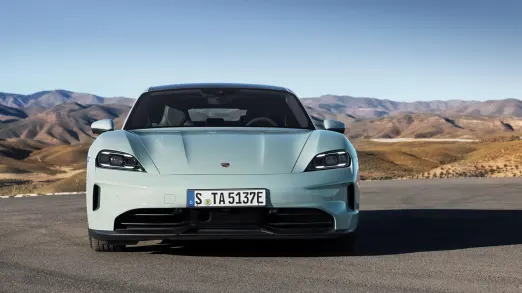
Original front-end design on a GTS and the revised design for 2025
As before, the rear-drive Taycan and all-wheel-drive Taycan 4S are available with two battery options, both of which are upgraded for 2025. The standard Performance goes up to 89 kilowatt-hours (previously 70), while the optional Performance Plus now crosses the triple-digit threshold at 105 kWh (previously 93). Range estimates were not available for the standard battery, but Porsche claims the rear-drive/Performance Plus combo now travels 35% further for a total of 421 miles when using the optimistic European WLTP testing standard. Eventual EPA estimates should be much lower, but still north of 300 miles. Having more battery cells is certainly a big contributor, but there were many other tweaks, as well.
Improved thermal management, more efficient motors, improved wheel aerodynamics, and lower rolling resistance tires also come together to add precious range. High-speed brake regeneration has also increased by as much as 30%, according to Porsche. Altogether, that means you’ll have a good bit less range anxiety.
When you do need to replenish the battery, you’ll be spending less time at a DC fast-charger since the rate has increased from 270 kilowatts to 320 kW. In practical terms, you can get from 10% capacity to 80% in only 18 minutes under ideal conditions, as opposed to the 5-80% in 23 minutes its predecessor required. The Taycan accomplishes this with its ability to maintain its peak charge rate longer and in a wider band of operating temperatures, despite having a larger capacity than before. Of course, that assumes you can find an operational and unoccupied charger capable of such loads, but hey, progress is progress, right?
All of these improvements help with practicality, but Porsche drivers are all about performance. And they’ll definitely get it for 2025. Every Taycan powertrain/battery combo is improved, but there are a lot of combos, plus the “Overboost Power with Launch Control” function needed for max acceleration – it can get confusing. To keep things as simple as possible, we’re just going with the Launch Control numbers. With the Performance Battery, the base, rear-drive Taycan increases to a 402-horsepower maximum from 321 horsepower. The Performance Battery Plus ups that to 429 hp from 375 hp. The all-wheel-drive 4S now produces 536 hp/590 hp (Performance/Performance Plus), versus 429 hp/482 hp.
Then there are the Turbo models, which all get the bigger battery. The Taycan Turbo now produces 871 hp with Launch Control, up from 616. That’s far more than the old Turbo S, which now finds itself with 938 hp versus 750. Woof. Porsche says the Turbo S now hits 62 mph in 2.4 seconds, an improvement of 0.4 second.
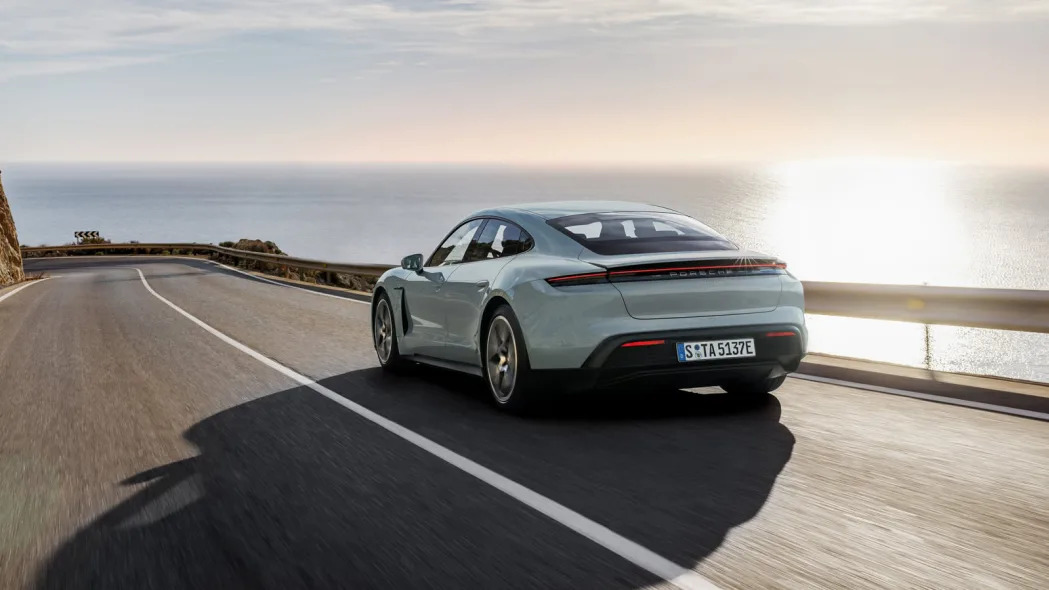
I managed to snag a Turbo sedan for the drive between Seville and the Circuito Monteblanco racetrack on a challenging scenic route and can unequivocally state that I was not wanting for more power. Launch control still manages to trigger a guttural giggle as your organs slosh around in your ribcage, providing the kind of confidence when passing slower traffic on narrow roads that few other cars can offer. With the artificial “Electric Sport Sounds” on, you get better feedback of how hard you’re driving, and there’s even a subtle indication of the rear motor’s two-speed transmission shifting.
The brake-by-wire system gets the 5,000-plus-pound sedan slowed in a hurry, and it’s also easy to modulate when you feel like trailing the pads all the way down to an apex. There’s no appreciable transition between brake regeneration and when the physical binders take hold, but the pedal itself feels slightly spongy for a performance car. Tapping the new push-to-pass button on the steering wheel gives you a bit more oomph for a moment, but if you’re expecting a “go-baby-go” nitrous button, this isn’t it.
The steering is delightfully precise, but there’s little to no feedback for the driver to determine how much front tire grip has been exhausted — a common refrain heard from aging drivers like myself. The steering effort is also a bit too light for my tastes, but then again, my arms weren’t worn out after the lengthy drive.
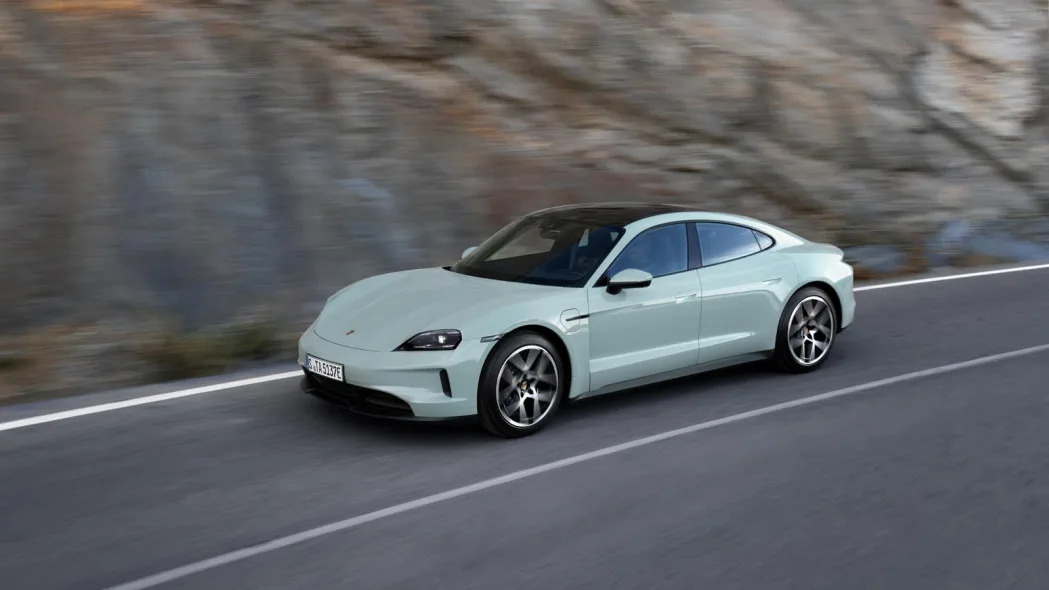
The real star of the show is the Taycan’s handling, ensuring that it rightfully deserves the Porsche badge. Having the battery weight low in the floor certainly helps make the hefty Taycan feel lighter than it is, but Porsche’s new Active Ride suspension adds another dimension. For the most part, you won’t know it’s there as you slice through curves and switchbacks. It’s only when you see that the dashboard is staying impressively level with the horizon that you realize its worth. Body roll is damn-near imperceptible, yet the ride remains compliant enough to not feel nervous or harsh.
The body motions are well-tuned to not feel as odd as Mercedes’ Active Curve system that leans the vehicle in like a motorcyclist. There is some weirdness when making minute steering corrections in the middle of a turn, though. At first, my drive partner and I chalked it up to the four-wheel-steering or perhaps lane-keep assist, but after a brief consultation with a Porsche handler, it seems more likely it’s the active suspension. The sensation is slight enough to not even notice unless you’re actively seeking it out, and if it is bothersome, it can be turned off. We kept it on and concentrated more on keeping our steering precise.
Just as noteworthy as the Taycan’s cornering abilities is its ride comfort. In lesser vehicles, you’d be forced to endure a punishingly firm ride, but the Active Ride system deftly smoothes over the rough spots. It’s not EQS smooth, but it’s nowhere as stiff as other vehicles that can rail through turns like this, EV or otherwise. As an added bonus, when you stop and put the car in park, the suspension quickly lifts the body. The few inches of added seat height make for more graceful exits and entries.
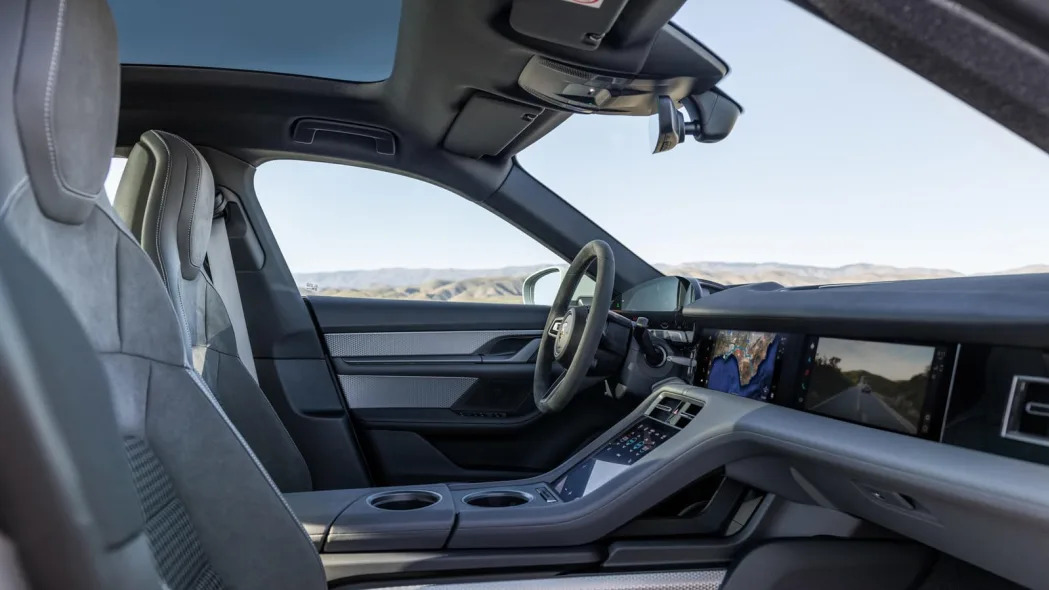
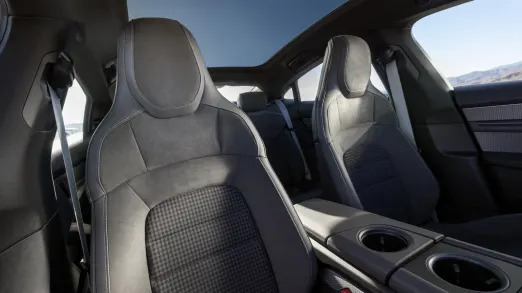

While there’s a lot new about the 2025 Taycan, the interior follows a familiar refrain. The tech interface is slightly revised to give more options and deliver more information. One especially helpful gauge breaks down charging rate and temperature for those who are interested or bored enough. Returning is an optional touchscreen for the front passenger, allowing them to play DJ, help with navigation, or enjoy streaming video. A privacy filter ensures the driver can’t be distracted, and it works well enough that it just looks like a piano black trim panel from an angle.
The lack of significant interior change is generally a very good thing since the Taycan was already solidly constructed and bathed in premium leather and racy suede materials (although just how premium and just how racy is subject to options boxes). The rear seats can still comfortably transport my 5-foot-10 frame with just a bit of headroom to spare. Unfortunately, the air vents still require diving into the central touchscreen to aim them. It’s incredibly distracting if you’re driving, a solution to a non-existent problem and something Porsche has already walked away from in recent redesigns like the Cayenne, Panamera and Macan Electric.
As far as annoyances go, though, this is about as minor as it gets and does nothing to sully the Taycan’s overall excellence.
Of course, this kind of excellence doesn’t come cheap. The base rear-drive Taycan starts at $101,395 (including $1,995 in destination fees). That’s an $8,500 increase over the 2024 model, but it does include a wealth of newly standard features, including adaptive air suspension, blind-spot warning, extra charge ports, wireless phone charging, a heated steering wheel with drive mode switch, and charge ports on both sides of the car. The Turbo I drove starts at $175,595 and held an as-tested price of $203,395. The Turbo S surpasses even that with a $210,995 price of admission. As past sales have indicated, the Taycan is Porsche’s best-selling model that isn’t an SUV, so it’s unlikely the price increase will deter wealthy clients when it shows up in dealerships this summer. The sleek, wagon-like Cross Turismos will arrive later in the fall.
With all of these improvements, the Porsche Taycan remains the go-to choice for all-electric performance in a very limited field. Even better, there’s room to grow in the form of the Taycan Turbo GT, which I’ve lovingly nicknamed Taycanasaurus Rex. Look for my story about that model here in a week.



